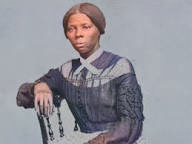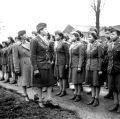 Harriet Tubman is one of the most inspiring and well-known figures in American history. Born into slavery, she escaped and made thirteen missions to rescue over seventy slaves using the Underground Railroad. She was an extraordinary, brave woman who inspired many with her relentless drive to help other slaves to freedom.
Harriet Tubman is one of the most inspiring and well-known figures in American history. Born into slavery, she escaped and made thirteen missions to rescue over seventy slaves using the Underground Railroad. She was an extraordinary, brave woman who inspired many with her relentless drive to help other slaves to freedom.
Tubman’s early life
Tubman was born Araminta Ross, but her actual birthday is unknown, and estimates place it between 1820 – 1822 in Dorchester County, Maryland. Tubman’s mother, a very religious woman, called her daughter ‘Araminta’ after a passage in the Bible book about Moses.
She was the fifth of nine children. Her parents were Benjamin Ross and Harriet Green. Tubman’s owners rented her out to neighbors as a domestic servant by the age of five. Early signs of her resistance to slavery and its abuses came at age twelve when she intervened to keep her master from beating an enslaved man who tried to escape. She was hit in the head with a two-pound weight, leaving her with a lifetime of severe headaches and narcolepsy.
When she was young, Tubman worked as a housekeeper for a wealthy white family. One day a new slave, who had escaped from his plantation, came to the house. The slaves were given food and locked in their rooms for the night. The new slave was strong and healthy; he hit the door so hard that he split it open. He ran out, and the white family feared he would go to the law. They told Tubman to help them catch the slave. She refused because she knew that if she helped them, they would later blame her for the escape and punish her. The slave was never caught.
Freedom from Slavery
In 1860, at the start of the Civil War, Tubman married a free black man named John Tubman. He was a carpenter and supported her in her efforts to help slaves escape. In the spring of 1863, a fugitive slave named Charles Nalle ran away from his master in Virginia. A manhunt was started to find him and bring him back. He was caught by slave catchers and put into jail. Tubman heard about this, and she knew what would happen to him. She dressed like a man and went back into the slave states. She had to be very careful not to get caught herself.
Tubman could get into jail, but it wasn’t easy. She had to bribe one of the guards with five dollars. Tubman carried a pistol and a knife. When she got into the jail, her gun was cocked and pointed at the head of the man who was guarding Charles Nalle. Before he could get his gun, she held the gun to his head and pulled the trigger. Then she took Charles Nalle out of jail. Tubman carried a small compass to help her find her way through the woods.
Conductor On The Underground Railroad
She was very good at finding her way through the woods. After escaping, she returned to Maryland to help other slaves flee, including her family. Her family lived in Cambridge, Maryland. She knew they would be captured and sent back to slavery if she went there to get them. So she sent her brother to go and get them. He pretended to be a slave trader and rescued her parents and siblings. A doctor named William Still helped Tubman by recording the names of slaves that escaped from their owners. She then went back into the south and got them out. She usually charged $10 to take a group of slaves to freedom in the north. She made several trips and helped over 300 slaves reach freedom in Canada.
In one trip, Tubman led seven people on a two-month-long journey. They traveled at night, hiding by day. They would travel about 10 miles each night and rest during the day. This was called “the underground railroad” because the slaves had to travel on secret paths that ran beneath stations along their journey. They could take a steamboat ride to freedom in New York when they reached Pennsylvania.
While Tubman was helping slaves travel to freedom, she became a spy for the union. She would lead Union soldiers to Confederate soldiers and supply trains. No one knows how many lives she saved. After the Civil War, Tubman worked with the Freedmen’s Bureau. She helped thousands of freed slaves find jobs. She helped them get food, clothing, and shelter. Without her help, many of these freed slaves would have died from sickness or starvation. She also helped many freed slaves to learn how to read and write.
Later years and legacy
In 1869, Tubman moved to Auburn, New York. There she opened a home for poor and elderly black people. Tubman organized the Aid Association of Colored Women’s Clubs in 1896. She also helped white people that were being persecuted. Tubman died on March 10, 1913. She was buried in Fort Hill Cemetery in Auburn. Her home in Auburn was turned into a National Historic Site in 1976.
In 1984, Congress passed legislation to give her a special pension. In 2002, the U.S. Department of the Interior recognized her as a National Historic Person. She is remembered as one of the greatest Americans ever.
TRAILER OF HARRIET MOVIE (2021)
Featured Biography
 Harriet Tubman: The Road To Freedom
Harriet Tubman: The Road To Freedom









